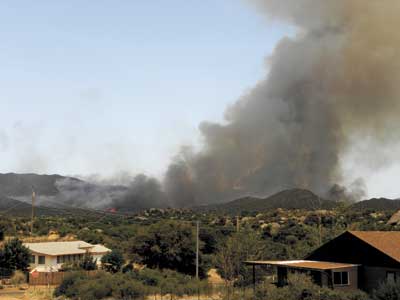BY LINDA BENTLEY | OCTOBER 2, 2013
Investigation of Yarnell Hill Fire concludes no indication of negligence
According to the report, temperatures exceeded 2000 degrees and the deployment site was not survivable
PRESCOTT – The Yarnell Hill Fire Serious Accident Investigation Report, regarding the 19 Granite Mountain Interagency Hotshot Crew (IHC) members that lost their lives on June 30, was released on Saturday during a press conference and concluded: “The judgments and decisions of the incident management organizations managing this fire were reasonable. Firefighters performed within their scope of duty, as defined by their respective organizations. The Team found no indication of negligence, reckless actions, or violations of policy or protocol.”
 The fire, which began high on a ridge west of Yarnell on June 28, 2013 when lightning ignited multiple fires, quickly grew out of control and forced a mandatory evacuation of Yarnell and Peeples Valley by June 30.
The fire, which began high on a ridge west of Yarnell on June 28, 2013 when lightning ignited multiple fires, quickly grew out of control and forced a mandatory evacuation of Yarnell and Peeples Valley by June 30.
Originally under the jurisdiction of the Arizona State Forestry Division, the fire started in a boulder field in steep terrain with no vehicle access and was about one-half acre in size.
The following day, resources held the fire in check until around 4 p.m. when winds increased and the fire began spreading outside containment lines.
That evening the Type 4 Incident Commander ordered a Type 2 Incident Management Team (IMT) and additional resources for the next morning.
The fire grew to an estimated 300-500 acres by morning.
Early that morning the incoming Granite Mountain IHC Superintendent accepted the role of Division Alpha Supervisor with an assignment of establishing an anchor point at the heel of the fire with the Granite Mountain IHC and the Type 2 IMT assumed command.
The report explains how the fire spread to the northwest for most of the day threatening structures in Model Creek and Peeples Valley but winds shifted at around 3:30 p.m. and the fire started pushing aggressively to the southeast toward Yarnell.
Resources then shifted to resident evacuation and structure protection in town.
At the time only the Granite Mountain IHC remained out on the ridge on the southwest perimeter of the fire.
Personnel in communication with IHC knew the crew was “in the black” at the time and assumed they would stay there. Apparently no one knew they left the black and headed southeast sometime after 4 p.m.
At 4:30 p.m. a thunderstorm increased winds substantially, the fire turned south and overran the Granite Mountain IHC at around 4:42 p.m., which is when they became entrapped and deployed their fire shelters.
The investigative team noted there was a gap of over 30 minutes in the information available for the Granite Mountain IHC from 4:04 p.m. until 4:37 p.m., where the team cannot verify communications from the crew.
The team also points out “There is much that cannot be known about the crew’s decisions and actions prior to their entrapment and fire shelter deployment …”
The intensity and direction of the fire spread, rapidly advancing, eliminated the crew’s options of reaching the safety zone or returning to the canyon rim, leaving them less than two minutes to improve a deployment site.
According to the report, temperatures exceeded 2,000 degrees and the deployment site was not survivable.
The 19 crewmembers were found approximately one mile south-southeast of their last known location, about 600 yards west of the safety zone at the Boulder Springs Ranch.
The investigative team concluded the Granite Mountain IHC was a fully qualified, staffed and trained hotshot crew that was current on all training, met work/rest guidelines, and followed all standards and guidelines as stated in the Standards for IHC Operations and the Arizona State Forestry Division’s Standard Operational Guideline 804.
Because the Yarnell Hill area had not experienced a wildfire in over 45 years, it was primed to burn because of extreme draught.
Despite Yavapai County having a Community Wildfire Protection Plan in place, over 100 structures were not defendable by firefighters.
The report also cites challenging radio communications along with the fire’s complexity increasing in a very short period of time as contributing factors.
As the complexity of the fire dramatically increased, beginning Saturday evening, fire management went through multiple transitions from a Type 4 through a Type 1 incident in less than 20 hours.
The report said despite the Granite Mountain IHC watching the active fire burn away from their position all day, “their observations did not lead them to anticipate the approaching outflow boundary or the accompanying significant fire behavior changes” that included “a doubling of fire intensity and flame lengths, a second 90-degree directional change, and a dramatically accelerated rate of spread.”
The report also concluded, “The judgments and decisions of the incident management organizations managing this fire were reasonable. Firefighters performed within their scope of duty, as defined by their respective organizations. The team found no indication of negligence, reckless actions or violations of policy or protocol.”
The report was done in two parts with Part One providing a fact-based narrative of the incident with the investigative team’s analysis, conclusions and recommendations.
Part Two, the discussion section, explores multiple concepts and perspectives, “in order to support the broader community seeking to make sense of the accident …”




